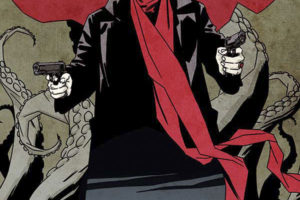 Rocambole is an early French character who is a forerunner of many similar characters of heroic fiction that followed him. These stories were written in the 1850s and 1860s. But until now, there has not been an English translation of the series.
Rocambole is an early French character who is a forerunner of many similar characters of heroic fiction that followed him. These stories were written in the 1850s and 1860s. But until now, there has not been an English translation of the series.
I have posted previously about Rocambole, looking at the first two of three volumes of English translations by Basil Balian. Now we will look at the third and final volume, “Rocambole, Vol. 3: The Crusade.”
But for those who haven’t read the previous posts, some background: The reason these stories haven’t been translated before is the difficulty of doing so. The original stories were serialized in newspapers, under the overall title of “The Dramas of Paris.” Think in terms of a soap opera in literary form.
Rocambole as a character appeared later on, and eventually took over the series.
The series has a wide number of characters, plots and subplots. The series was reprinted in a series of nine novels. (I have no idea where the translator gets the claim of 17 novels. All the lists I’ve seen give only nine. I can only assume in Iraq, were the translator grew up, the series was published in more books.)
Balian has adapted these novels into three volumes of four “books” each. So there is not quite a one-to-one matchup with the novels.
The first volume deals with Rocambole at the beginning, when he was a villain. The second one deals with his redemption and early work as a hero. The third (this one) deals with him being a larger-than-life hero. My main source of information on this character and the series has been the page on Rocambole at the Cool French Comics site associated with Black Coat Press.
This volume actually includes novels 6, 7, 8 and 9: “Rocambole’s Last Word,” “The Miseries of London,” “The Demolitions of Paris” and “The Hanged Man’s Rope.” And actually, for novel number six, we are getting the end of it, as most of it appeared in the prior volume. Further, novel 9 was unfinished by Ponson du Terrail‘s sudden death during the German invasion of France in 1871. The translator has added an epilogue to close things out.
Book 9 comprised the rest of “Rocambole’s Last Word,” which focuses on Marmouset dealing with a dangerous woman known as the “Beautiful Gardener” while Rocambole is away in India. We get a prologue that explains that Marmouset had married Gypsy, who subsequently passed away after a sudden illness. Marmouset sets out on a new case for Rocambole that involved finding out what happened to a missing Marques. This bring him into contact with Roumia (here as Romia), the so-called “Beautiful Gardner.” We learn the story behind Roumia and her connection with the Marques. In going after her, Marmoset and Vanda (another associate of Rocambole from the last volume) are captured by Roumia. But then Rocambole returns and rescues them all, and is off to London with Roumia.
Rocambole is working to finish the mission he started in the previous volume. He is still in pursuit of the evil Sir Linton, who has stolen part of the treasure of Rajah Osmany. We also learn that Rocambole is now to be the leader of the followers of Shiva (Siwa) in Europe, and that Roumia is the lover of Nadir, their leader. So Rocambole, assisted now by Roumia, is able to find Sir Linton. They relieve him of the treasure, and Roumia and Nadir return to India.
Book 10 is the “Miseries of London,” and has Rocambole still in London, his associates having returned to Paris. Rocambole is working to help those in need when he is pulled into a matter dealing with Irish independence. A young boy is missing, and it appears that he will receive a large inheritance, as well as being an important figure to Irish independence. Against him is Lord Polmure and his daughter Miss Ellen, and the evil Anglican Bishop Towne. Rocambole is assisted by Irish priest Father Samuel, and a beggar known only as Shocking, who knows Rocambole only as “Mr. Frown.” The young boy, Ralph, turns out is the nephew of Lord Polmure. He wishes to get his hands on the boy to both thwart the Irish rebels and to restore the lands lost when Ralph’s father became an Irish rebel. The plot moves back and forth as the different groups work to get their hands on Ralph. Finally Rocambole and associates succeed, but Rocambole is now in prison!
Book 11 is the “Demolitions of Paris.” Rocambole is in Newgate Prison, but others are working to free him. Miss Ellen, now realizing her love for him, has gone to Paris to find his associates to break him out. But her father is out for revenge and sends British agent James Woods to stop her. She is assisted by the young Limousin in a scene set in some buildings being demolished in Paris (hence the title) and he is able to contact Milion (another Rocambole associate from the previous volume) about her. Milion alerts Marmouset. Adding to the mix, Shocking, Ralph and his mother are also in Paris, and they are still threatened. So Marmouset and the rest have to both save Ralph and his mother but also free Miss Ellen. Having learned of Rocambole’s plight, they head to London to free him. At the same time, Irish rebels are doing the same thing! Will they succeed before Rocambole is executed?
Book 12 is “The Hanged Man’s Rope.” Now out of jail, Rocambole is on a new mission to help someone. While in prison, he met the servant of a noble family who had strived for years to right a mis-justice, but was unable to do so before he was hanged (hence the title). We learn the complex story of how and why Evandale Pemperton had stolen the title and fortune from his half-brother William, and succeeded in sending him off to Australia. Working to correct this, Rocambole runs afoul of Bishop Towne again, who is working for Evandale’s father-in-law. Rocambole is able to get justice for William, but he and his associates are still in danger from Bishop Towne. And sadly, the story ends here.
As noted, the author died during the German invasion of France in 1871 at the age of 42. Certainly he would have lived for several more decades, and would probably have continued to write new stories of Rocambole and associates. We learn in this final story that Rocambole was in his early 40s as well. What might have happened? Might he have married Miss Ellen, as it seems to be hinted here? Might he have passed along his mission to the younger Marmouset, as we see in two of the stories he took the lead for the absent or imprisoned Rocambole? Who knows.
Rounding out the work is a short epilogue by the translator. Set many years after the events of Book 12, we meet again two of the main characters. A well done wrap up, I thought.
Overall, I found this volume very enjoyable and a great finale to the whole series. The translator has adapted the work, bringing the language to a form more acceptable to modern audiences, and had trimmed and cut the various subplots, making the work overall very readable. I did think a few areas seem a bit shorter then I would have expected, like the wrap up of Book 9. But still a good read.
I recommend this series for any wanted a good adventure series.



